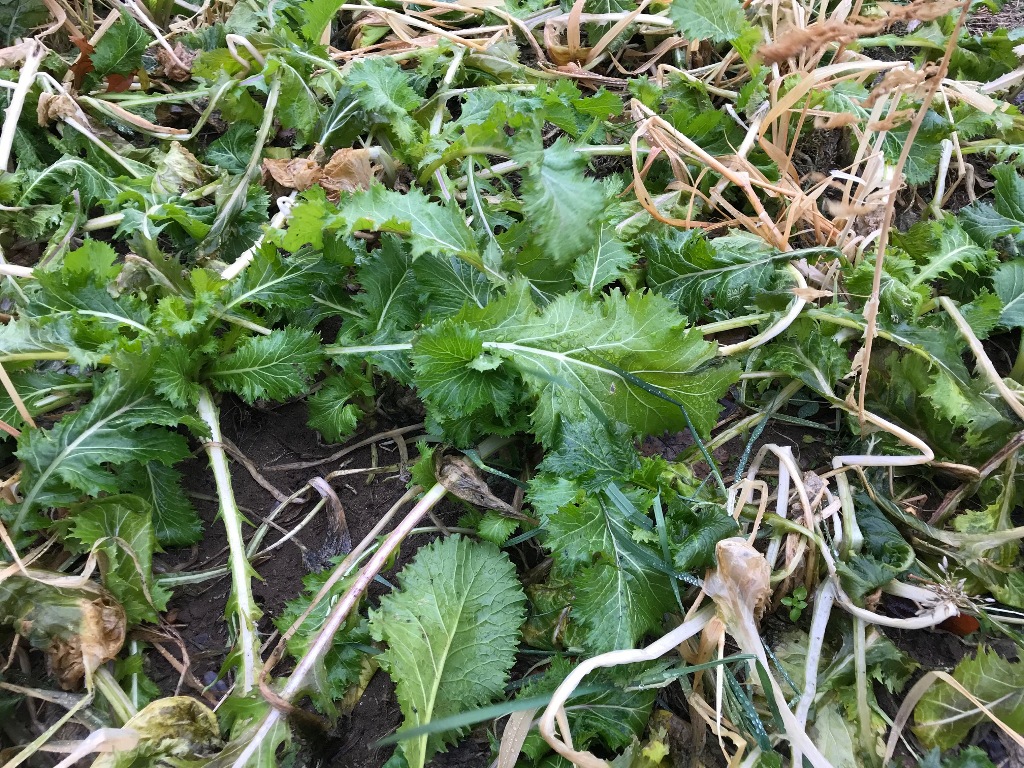brassicas
Brassicas are a great addition to a grazing program, especially those who are looking to extend the grazing season and reduce hay consumption.
Appin turnip leaves
Appin Forage Turnips
Appin turnip bulb
Appin forage turnip was bred to provide multiple grazings and for fast, vigorous establishment with quick maturity (50 – 80 days). It is firmly anchored in the ground for minimum wastage.
Appin has a significantly higher proportion of leaf yield compared to other turnip varieties and is multi-crowned for improved re-growth potential. Its high leaf-to-bulb ratio results in a very leafy crop with high digestibility. The tops on Appin have tested as high as 30% CP with a RFV of over 340.
Many producers have grazed Appin 4-6 times per season by utilizing proper grazing and fertility management practices.
Seed Appin at 2-5 lbs/acre. Do not plant a pure stand. Consider feeding low quality hay when grazing turnips. Cattle will use the low quality hay to regulate the passage rate of the lush turnip forage.
NOTABLE CHARACTERISTICS
- Bred for Grazing
- High leaf yield
- Excellent re-growth potential
- Firmly anchored bulb for minimum wastage
- Club-root tolerant
- Good frost resistance
Forager Mix
Forager Mix is a mix of Cereal Rye, Oats, and Appin Turnips. Seeding rate is 100 lbs./acre. The pictures below are from January 11, 2018. Temperature was 55 degrees. Three days prior was sub 0 temps and there was a lot of snow on the ground. You can see the dead oats. In the spring, the cereal rye will be available to graze.
Pasja Hybrid Turnip
SPRING PLANTED PASJA - 5 POUNDS PER ACRE, ALONG WITH 2 BUSHELS OF OATS
Pasja is a high energy, early maturing (50-70 days) hybrid forage brassica (forage turnip X forage rape) which has been bred for rapid growth, re-growth, and high performance. Pasja is a tap root type brassica.
Pasja can be used over a much longer period of time the traditional turnip or rape cultivars. It has exceptional regrowth ability and should provide good amounts of summer feed. Pasja is very productive and with good grazing and fertility management produces outstanding yields. Pasja produces exceptionally leafy forage with excellent nutritional value. Pasja turnips need 30-50 lbs/acre of actual N.
APPLICATIONS
- Supplement or Extend Grazing Season – Pasja can be used to supplement or extend the grazing season when cool season pastures slow down because of summer heat or the cold.
- Sow with BMR Sorghum-Sudangrass/Pearl Millet –Pasja adds high quality forage to the summer diet. Pasja re-grows along with the summer annual grasses for multiple grazings.
- Sow with cereal grains or annual ryegrass in the spring or late-summer. Pasja provides excellent tonnage and high quality forage to this mix for multiple grazings. Pasja also works well if sown after a cereal crop is harvested for late-summer/fall grazing.
- Break Crop - Pasja can also be used as a break crop in order to convert older pastures to different species and newer varieties. An annual crop gives a bigger window to eliminate the old undesirable forage through the use of herbicides, tillage and competition of the brassica crop itself.
BARKANT TURNIPS
Barkant is an improved forage turnip that combines higher leaf production and a purple tankard root (50% of the bulb is above the soil surface). Barkant produces high yields with good top growth.
Barkant is a diploid variety, with good resistance to bolting and very good disease resistance. The high sugar content provides winter hardiness and improved palatability.
Production of up to 4-6 tons/acre of dry matter under good grazing management is common. Crop maturity occurs in 60-90 days.
Excellent for stockpiling and strip grazing. Barkant turnips provide an excellent option for pasture renovation break crop.
For planting guidelines, see our Seeding Information Guide.



